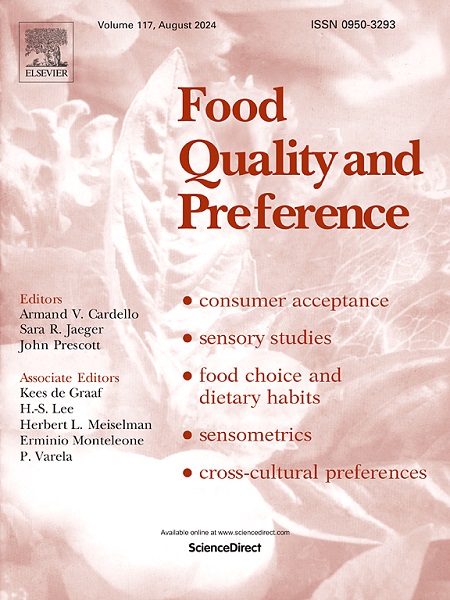与社会经济地位低下地区的青少年共同为学校食堂制作创新的、可被接受的豆类菜肴
IF 4.9
1区 农林科学
Q1 FOOD SCIENCE & TECHNOLOGY
引用次数: 0
摘要
推广可持续饮食,重视植物性食物并为其提供舞台,对人类和环境健康都有好处。青少年时期是支持健康和可持续饮食的关键时期。尽管如此,青少年仍然是一个研究不足的群体,尤其是那些经济地位较低的青少年。这项研究旨在通过与社会经济地位较低、移民率较高地区的青少年共同创作,为学校食堂开发创新、可持续和健康的豆类菜肴。19 名青少年和 4 名厨师参加了焦点小组反复讨论,采用多种方法("待完成的工作"、自由联想任务、SCAMPER(替代-组合-改编-修改-目的-删除-重新排列)技术)确定新豆类菜肴的创意。随后,91 名青少年根据这些想法对 28 种菜肴概念的尝试意愿进行了评分。结果表明,所有菜肴都受到了欢迎,但在有高度厌食症的青少年中接受度较低,但所选菜肴无一被拒绝。通过探索喜好的个体差异,发现了两个具有不同享乐模式的群组。该研究表明,与青少年共同创作,并了解个体差异,是为学校食堂开发创新、健康和广受欢迎的豆类菜肴的有效策略。本文章由计算机程序翻译,如有差异,请以英文原文为准。
Co-creating innovative and accepted legume-based dishes for school canteens with adolescents in a low socioeconomic area
The promotion of sustainable diets, that valorise and give stage to plant-based foods, is beneficial for both human and environmental health. Adolescence is crucial to support healthy and sustainable eating. Despite this, adolescents remain an understudied group, especially those with a lower economic status. This study aimed to develop innovative, sustainable and healthy legume-based dishes for school canteens through co-creation with adolescents in a low socioeconomic status area with high immigration rate.
Nineteen adolescents and four chefs participated in iterative sessions of focus group discussions using a combination of methods (Jobs-To-Be-Done, free association tasks, SCAMPER (Substitute-Combine-Adapt-Modify-Purpose-Eliminate-Rearrange) technique) to identify ideas of new legume-based dishes. Subsequently, 91 adolescents rated their willingness-to-try 28 dish concepts based on these ideas. Six concepts were selected and translated into prototypes that underwent further evaluation by 138 adolescents who assessed their liking, sensory and emotional responses.
Results showed that all dishes were well-received, with lower acceptance among high-neophobic adolescents, yet none of the selected dishes were rejected. Exploring individual differences in liking identified two clusters with different hedonic patterns. Emotional characterization of dishes showed those that elicit positive emotional responses high in arousal and novelty in all adolescents, independently from food neophobia, increasing their likelihood of acceptance.
The study shows that co-creation with adolescents, in combination with understanding individual differences, are promising strategies to develop innovative, healthy and well-received legume-based dishes for school canteens.
求助全文
通过发布文献求助,成功后即可免费获取论文全文。
去求助
来源期刊

Food Quality and Preference
工程技术-食品科技
CiteScore
10.40
自引率
15.10%
发文量
263
审稿时长
38 days
期刊介绍:
Food Quality and Preference is a journal devoted to sensory, consumer and behavioural research in food and non-food products. It publishes original research, critical reviews, and short communications in sensory and consumer science, and sensometrics. In addition, the journal publishes special invited issues on important timely topics and from relevant conferences. These are aimed at bridging the gap between research and application, bringing together authors and readers in consumer and market research, sensory science, sensometrics and sensory evaluation, nutrition and food choice, as well as food research, product development and sensory quality assurance. Submissions to Food Quality and Preference are limited to papers that include some form of human measurement; papers that are limited to physical/chemical measures or the routine application of sensory, consumer or econometric analysis will not be considered unless they specifically make a novel scientific contribution in line with the journal''s coverage as outlined below.
 求助内容:
求助内容: 应助结果提醒方式:
应助结果提醒方式:


